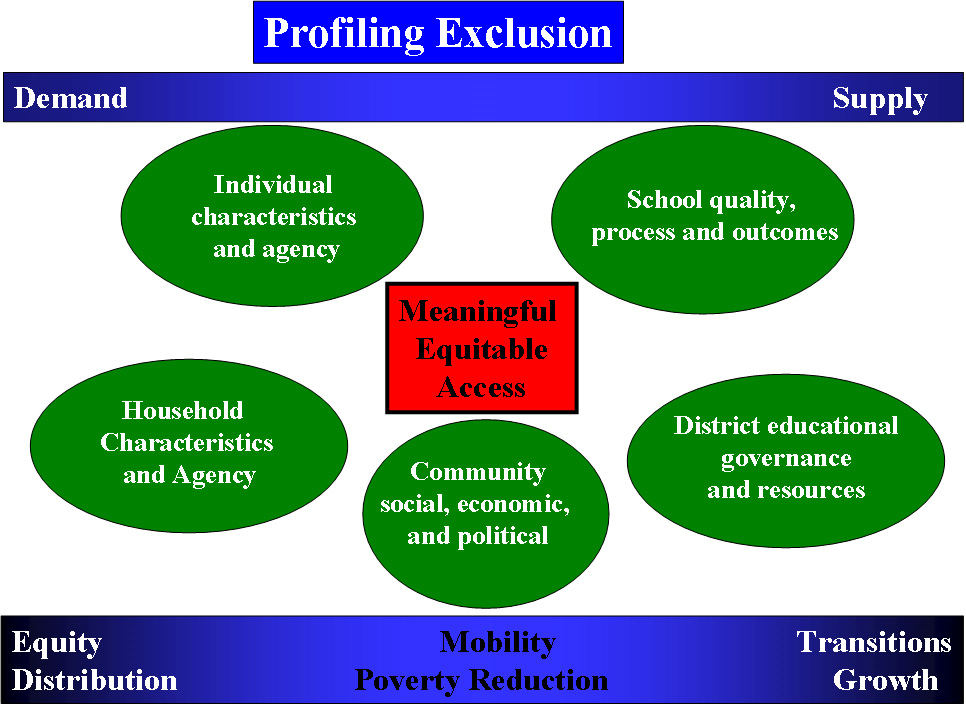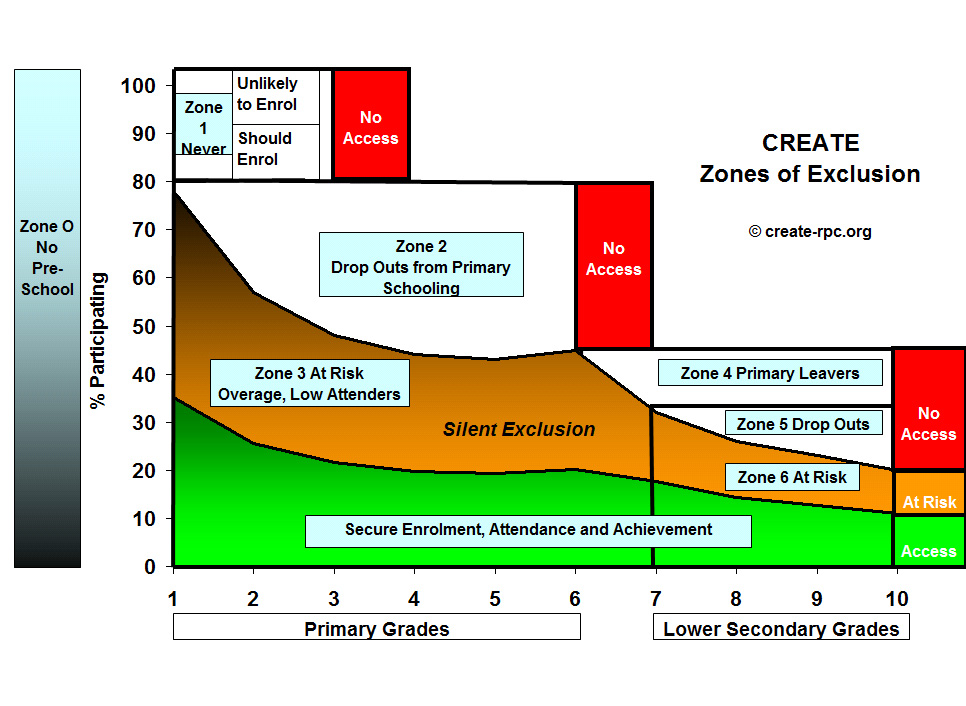Conceptual Background
CREATE uses key concepts which inform the focus of its research. These are explored below.
Access to education: Initial access has little meaning unless it is meaningful and results in (i) regular attendance (ii) progression (iii) learning; and (iv) appropriate access to post-primary education. Meaningful and equitable access to education is shaped by the interaction of a range of factors which are illustrated in the table.

Zones of exclusion: CREATE uses the term 'zones of exclusion' to describe the various spaces where children are included, excluded, or are at risk of exclusion from education. Children falling into these zones of exclusion are the subject of our research. Many of these children are from disadvantaged groups, e.g. the very poor, girls, HIV/AIDS orphans, displaced people, ethnic minorities, etc.
There are six main zones of exclusion. The Figure below presents a cross sectional model by grade of participation which locates those who are losing or have lost access to conventional education systems. It illustrates how typically enrolments decline steeply through the primary grades in low enrolment countries, and how those attending irregularly and achieving poorly fall into “at risk” zones. In this hypothetical model more than half of all children leave before completing primary school, and about half of the primary completers are selected into lower secondary school where attrition continues.
CREATE Conceptual Model Zones of Exclusion from primary and secondary school

Zone 1 contains those denied any access. Expansion of conventional schooling can enrol a proportion of these children, but is unlikely to embrace all in the near future. Research is being carried out into the circumstances that surround those without access to schooling to establish how their basic education needs might best be met.
Zone 2 includes the great majority of children who are excluded after gaining initial entry and drop out from primary school. Typically, drop out is greatest in the early grades, with a substantial push-out also present at the transition to secondary school. Precursors to drop out include repetition, low achievement, previous temporary withdrawals and low attendance.
Zone 3 includes those children in primary school but at risk of dropping out. Children who remain formally enrolled in school may be silently excluded if their attendance is sporadic, their achievement low or they are overage for their grade.
Zone 4 contains those children failing to transit to (lower) secondary school. These children might be excluded as a result of failing to be selected, being unable to afford costs or dropping out at this stage. Access to secondary schooling promotes the social mobility needed to give poor households more access to higher income employment.
Zone 5 includes those children who have entered (lower) secondary school but who fail to progress to the end of its cycle. Reasons for drop out at this stage include poor performance, affordability, and pregnancy. Demand to remain in school may weaken as a result of high opportunity costs where work is available.
Zone 6 includes (lower) secondary school children at risk of drop out. Some will be silently excluded though enrolled and at risk as a result of poor attendance and low achievement. Costs and affordability are also likely to be significant.
An additional Zone of Exclusion - Zone 0 - refers to pre school participation. This is very poorly detailed, though it is clear that in low enrolment countries large majorities experience little or no access to organised pre-school, and those that do are often enrolled in high cost private facilities.
In summary the CREATE Zones are:
- Zone 0 – children who are excluded from pre-school;
- Zone 1 -children who have never been to school, and are unlikely to attend school;
- Zone 2 - children who enter primary schooling, but who drop out before completing the primary cycle;
- Zone 3 - children who enter primary schooling and are enrolled but are “at risk” of dropping out before completion as a result of irregular attendance, low achievement, and silent exclusion from worthwhile learning;
- Zone 4 – children who fail to make the transition to secondary school grades;
- Zone 5 children who enter secondary schooling but who drop out before completing the cycle;
- Zone 6 children who enter secondary schooling and are enrolled but are “at risk” of dropping out before completion as a result of irregular attendance, low achievement and silent exclusion from worthwhile learning.